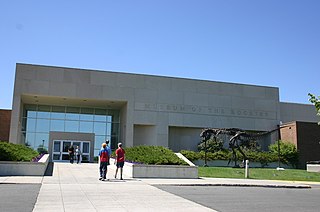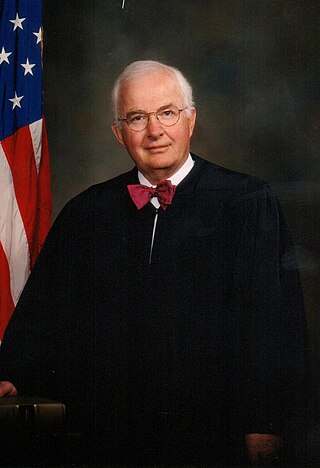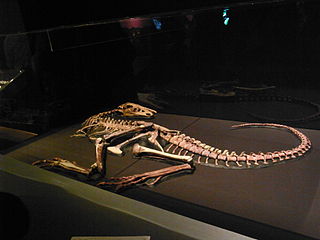
Tyrannosaurus is a genus of large theropod dinosaur. The species Tyrannosaurus rex, often called T. rex or colloquially T-Rex, is one of the best represented theropods. It lived throughout what is now western North America, on what was then an island continent known as Laramidia. Tyrannosaurus had a much wider range than other tyrannosaurids. Fossils are found in a variety of rock formations dating to the Maastrichtian age of the Upper Cretaceous period, 68 to 66 million years ago. It was the last known member of the tyrannosaurids and among the last non-avian dinosaurs to exist before the Cretaceous–Paleogene extinction event.

Hill City is the oldest existing city in Pennington County, South Dakota, United States. The population was 872 at the 2020 census. Hill City is located 26 miles (42 km) southwest of Rapid City on U.S. Highway 16 and on U.S. Route 385 that connects Deadwood to Hot Springs. Hill City is known as the "Heart of the Hills", a distinction derived from its proximity to both the geographical center of the Black Hills, and the local tourist destinations.

The National Museum of Natural History is a natural history museum administered by the Smithsonian Institution, located on the National Mall in Washington, D.C., United States. It has free admission and is open 364 days a year. In 2022, with 3.9 million visitors, it was the most-visited museum in the United States.

Museum of the Rockies is a museum in Bozeman, Montana. Originally affiliated with Montana State University in Bozeman, and now also, the Smithsonian Institution. The museum is largely known for its Paleontological collections as well as having the largest collection of North American Dinosaur fossils in the United States. They also possess the largest Tyrannosaurus skull ever discovered, as well as the thigh bone of a Tyrannosaurus Rex that contains soft-tissue remains. The museum is part of the Montana Dinosaur Trail and is Montana's official repository for Paleontological specimens.
Susan Hendrickson is an American explorer and fossil collector. Hendrickson is best known for her discovery of the remains of a Tyrannosaurus rex in South Dakota on August 12, 1990, in the Cheyenne River Reservation. Her discovery is the most complete skeleton of Tyrannosaurus known to science. This skeleton is now known as "Sue" in honor of her. It is on display at the Field Museum in Chicago, Illinois. She has also found other important fossils and artifacts around the world.

Tyrannosaurus rex is unique among dinosaurs in its place in modern culture; paleontologist Robert Bakker has called it "the most popular dinosaur among people of all ages, all cultures, and all nationalities". Paleontologists Mark Norell and Lowell Dingus have likewise called it "the most famous dinosaur of all times." Paleoartist Gregory S. Paul has called it "the theropod. [...] This is the public's favorite dinosaur [...] Even the formations it is found in have fantastic names like Hell Creek and Lance." Other paleontologists agree with that and note that whenever a museum erects a new skeleton or bring in an animatronic model, visitor numbers go up. "Jurassic Park and King Kong would not have been the same without it." In the public mind, T. rex sets the standard of what a dinosaur should be. Science writer Riley Black similarly states, "In all of prehistory, there is no animal that commands our attention quite like Tyrannosaurus rex, the tyrant lizard king. Since the time this dinosaur was officially named in 1905, the enormous carnivore has stood as the ultimate dinosaur."

The Burpee Museum of Natural History is located along the Rock River in downtown Rockford, Illinois, United States, at 737 North Main Street.

Peter Lars Larson is an American fossil dealer who is head of the Black Hills Institute of Geological Research, which specialises in the excavation and preparation of fossils. He led the team that excavated "Sue", one of the largest and most complete specimens of Tyrannosaurus rex, which was the subject of a legal dispute resulting in its seizure and public auction. In 1996, Larson was convicted of customs violations related to failing to declare money he had brought from overseas as well as taking two fossils from federal land, and served 18 months in prison.

Sue is the nickname given to FMNH PR 2081, which is one of the largest, most extensive, and best preserved Tyrannosaurus rex specimens ever found, at over 90 percent recovered by bulk. FMNH PR 2081 was discovered on August 12, 1990, by American explorer and fossil collector Sue Hendrickson, and was named after her.

"Stan", also known by its inventory number BHI 3033, is a Tyrannosaurus rex fossil found in the Hell Creek Formation in South Dakota, just outside of Buffalo in 1987, and excavated in 1992. It is the fifth most complete T. rex fossil discovered to date, at more than 70% bulk. In October 2020, the fossil was sold for $31.8 million at auction, making it the most expensive dinosaur specimen and fossil ever sold. In March 2022 Abu Dhabi's Department of Culture and Tourism stated that they had acquired Stan and were planning on displaying the fossil at a new museum of natural history scheduled to open in 2025.

Tyrannosaurus rex is one of the most iconic dinosaurs and is known from numerous specimens, some of which have individually acquired notability due to their scientific significance and media coverage.

Richard Howard Battey was a United States district judge of the United States District Court for the District of South Dakota.

Raptorex is a potentially dubious genus of tyrannosaurid dinosaur. Its fossil remains consist of a single juvenile specimen probably uncovered in Mongolia, or possibly northeastern China. The type species is R. kriegsteini, described in 2009 by Sereno and colleagues. The genus name is derived from Latin raptor, "robber", and rex, "king". The specific name honours Roman Kriegstein, a survivor of the Holocaust, whose son Henry Kriegstein donated the specimen to the University of Chicago for scientific study.

The T.rex Discovery Centre is a natural history museum located in Eastend, Saskatchewan, Canada, and housed in a building designed by Stantec. The T.rex Discovery Centre was opened to the public in 2001, and was intended to house a number of fossils, including the remains of a Tyrannosaurus nicknamed "Scotty" which was found nearby in 1991. Management of the T.rex Discovery Centre was assumed by the Royal Saskatchewan Museum in 2013.

Trix is a Tyrannosaurus rex specimen excavated in 2013 in Montana, United States by a team of paleontologists from the Naturalis Biodiversity Center in Leiden, the Netherlands and Black Hills institute of Geological Research in South Dakota. This Tyrannosaurus, over thirty years old – the oldest known Tyrannosaurus specimen – lived about 67 million years ago. It is considered to be the third most complete Tyrannosaurus found, with between 78% and 80% of its bone volume recovered. The specimen was named Trix after the former Queen Beatrix of the Netherlands. It is one of only two Tyrannosaurus specimens on permanent exhibit in mainland Europe. The other one is a specimen named Tristan on exhibit at the Natural History Museum of Berlin.

Big John is a fossilized Triceratops horridus skeleton discovered in South Dakota's Hell Creek geological formation in 2014. It is the largest known Triceratops skeleton, according to the team that assembled the fossil. Big John's 2021 auction price of €6.6 million made it the most expensive Triceratops skeleton; its high price signaled increasing demand for dinosaur fossils among private collectors and prompted discussion about the drawbacks of private fossil ownership for scientific research.

Titus is an obsidian black skeleton of a Tyrannosaurus rex discovered in the Hell Creek Formation, Montana, United States in 2014 and excavated in 2018.
The Naranjo Museum of Natural History is a museum located in Lufkin, Texas.

Scotty is the nickname for the Tyrannosaurus rex fossil, catalogued as RSM P2523.8, that was discovered in Saskatchewan, Canada in 1991. The fossilised remains were painstakingly removed, almost completely by hand, over two decades from the rock in which they were embedded. When the preparation was complete in 2011, a ~65% complete T. rex skeleton was revealed.


















